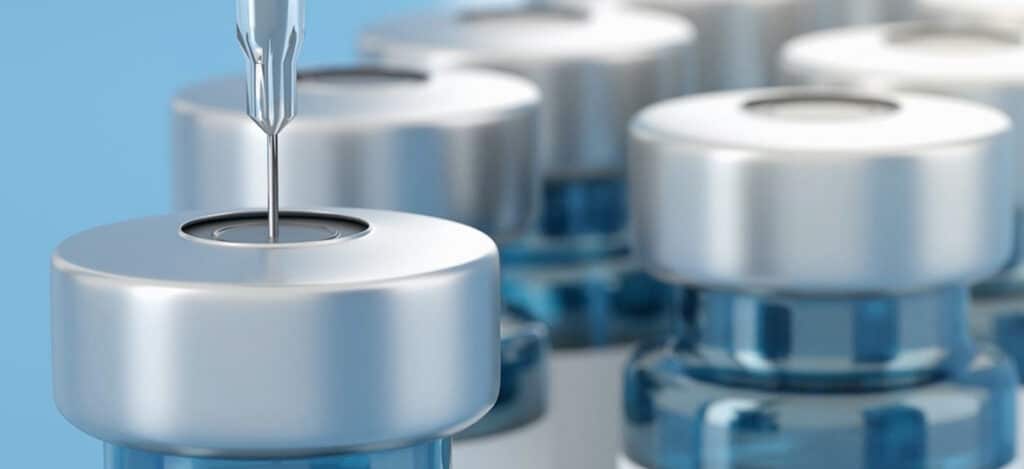How To Capitalize On Large Volume Parenteral Market Expansion
The market for large volume injectables (LVIs) has expanded in response to the rise in cancer diagnosis. Additional LVI market drivers include elevations in the number of surgeries per year, a growing need for faster drug administration routes, and a rising preference for single-dose administration of drugs. The LVI market is anticipated to continue to increase at a compound annual growth rate of 6.9% over the next five years. For health care companies looking to gain a cut of the LVI profits, there are six primary LVI products your company could capitalize on. These products are electrolyte solutions, carbohydrate solutions, nutritional proteins, lipid emulsions, peritoneal dialysis solutions, and irrigating solutions. Each of these LVIs is described in further detail below.

Electrolyte Solutions
Electrolyte solutions contain ions that have been solubilized in water. These ions support the body in retaining fluid and rebalancing ion channels following extreme activity, sickness, or surgery. Medical electrolyte solutions have a sodium chloride (table salt) base of at least 0.9%. Specialized electrolyte solutions, like Lactated Ringer’s solution, contain sodium lactate, potassium chloride, calcium chloride, and sodium chloride. Dextrose (sugar) or sodium bicarbonate may also be used in electrolyte solutions.
Carbohydrate Solutions
Carbohydrate solutions are used to refuel the body during illness or after surgery. The most common carbohydrate solution is dextrose (%5) in water. A variation of Lactated Ringer’s solution contains dextran and is an electrolyte-carbohydrate combination solution.
Nutritional Proteins
All proteins in the human body are composed of 20 essential amino acids. Nutritional proteins are synthetic amino acid mixtures that contain nearly all 20 essential amino acids. These nutritional proteins are delivered parenterally for various reasons such as renal failure, hepatic failure, infection, extreme illness, burn recovery, or starvation.
Lipid Emulsions
Lipids are fats. Large volume emulsions serve as a source of nutrient fat for patients under nutritional therapy. Lipid emulsions are traditionally composed of soybean oil, water (pH 8), egg yolk phospholipid, and glycerin. Egg yolk phospholipid is an emulsifying agent that allows the water and oil components to mix. The glycerin supports the osmotic pressure of the solution.
Peritoneal Dialysis Solutions
Dialysis solutions have a large volume of glucose (0.5–4.25%) to remove waste (e.g., urea and potassium) and excess fluid from the blood. Dialysis solutions support waste removal when the kidneys are incapable of this (such as renal failure). Peritoneal dialysis uses the peritoneal membrane surrounding the intestine as a natural semipermeable membrane. When a specially formulated dialysis fluid is instilled around the peritoneal membrane, dialysis can occur by diffusion. Any excess fluid can be removed by osmosis by changing the dialysis fluid’s glucose concentration.
Irrigating Solutions
Irrigating solutions are used for flushing wounds and surgical sites before, during, and after surgery. The primary purpose is to wash away any debris to allow for clear tissue visualization during surgery or to cleanse a wound of dirt and bacteria. Irrigating solutions differ from injectable solutions in their package closure. Injectable solutions are sealed with a rubber closure that restricts entry to only a needle or injection spike. Irrigating solutions are closed with a screw cap that is twisted open (like bottled water). Despite different entry points, all irrigating and injectable solutions must be sterile, endotoxin-free, and particulate-free. Irrigating solutions often contain electrolytes (sodium chloride) and sometimes organics (e.g., glutathione) to help preserve cells and tissues.
Summary
Overall, the LVI market is anticipated to continue to rise over the next five years. For health care companies looking to profit from the rising LVI market, there are six primary LVI products you can capitalize on. These products are electrolyte solutions, carbohydrate solutions, nutritional proteins, lipid emulsions, peritoneal dialysis solutions, and irrigating solutions. Medical device companies may consider pairing a customized irrigating solution with their medical device products to improve the surgeon’s surgical experience and the patient’s outcomes after surgery. LVI products require sterile manufacturing or terminal sterilization processes and bacterial endotoxin testing. Ensure that you find a contract manufacturing or testing partner to support you with these evaluations should you wish to develop an LVI product of your own.
MycoScience is a contract manufacturing organization specializing in sterile syringe and vial filling. MycoScience also offers Preservative Efficacy Testing, Sterilization Validations, Bioburden Testing, Cleaning Validations, Microbial Aerosol Challenge Testing, Accelerated Aging, Microbiology Testing, Cytotoxicity Testing, Bacterial Endotoxin Testing, EO Residual Testing, Package Integrity Testing & Environmental Monitoring services medical devices and allied industries. MycoScience is an ISO 13485 certified facility.
References
Mordor Intelligence. LARGE VOLUME PARENTERAL (LVP) MARKET – GROWTH, TRENDS, COVID-19 IMPACT, AND FORECASTS (2021 – 2026).
Michael J. Akers. Sterile Drug Products Formulation, Packaging, Manufacture, and Quality. Drugs and the Pharmaceutical Sciences. Informa Healthcare. 2010.
Sharing this in your social netwroks

